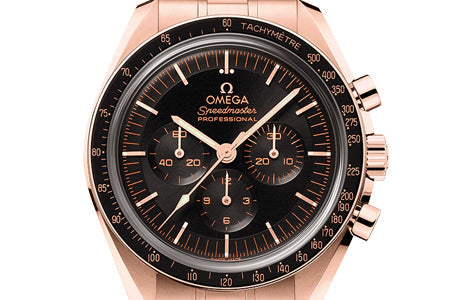UNDERSTANDING THE COLORS OF GOLD AND PROPRIETARY GOLDS



Long respected as a noble metal, gold was among the earliest metals to be formed into jewelry, artifacts and more. Early civilizations worshipped gold, paid homage to gold and held it up as a symbol of wealth and even religion. Today, gold pervades our cultures – as a color, as an adjective (think golden anniversaries and golden opportunities), as a metal and as an international monetary exchange.

A preferred choice for luxury watches (as well as platinum, of course), gold comes in many hues today – ranging from yellow gold to pink gold, rich rose gold, white gold and more. Some brands have even developed their own proprietary colors of gold that have warmer hues or that offer added benefits like enhanced scratch resistance. The colors and features are derived from additives mixed with the gold.
So, what creates the colors of gold? The different metals, and the varying amounts of those metals, that comprise the final 18-karat gold piece. These metals are added to the gold during the heating and melting process so that in the end, an 18-karat gold item is 75 percent pure gold.
- Yellow gold generally consists of 75 percent pure 24-karat gold and 25 percent silver and copper mixed in even parts. However, brands that want a warmer yellow shade will add more copper to the mix and less silver.
- White gold is created using 75 percent pure 24-karat gold mixed with white metals such as nickel, zinc or palladium.
- Pink, rose and richer gold hues are warmer tones than yellow and each is achieved by a adding a different amount of copper to the pure gold.For instance, the lighter-hued pink gold is typically referred to as 3N (75 percent pure gold, 12.5 percent silver and 12.5 percent copper).The slightly deeper rose gold is typically called 4N and consists of more copper than silver. The darker, almost red-colored, gold is referred to as 5N rose gold and consists of 75 percent puregold and 25 percent copper.


These colors of gold are the most prevalent used in watches. However, as mentioned, some brands formulate their own colors of gold, with hues ranging from honey to brown and more, and often with metals that help prolong the life of the gold or enhance its scratch resistance. Rolex boasts Everose gold and Chanel, for instance, has its own patented Beige gold that exudes a softer, warmer tone than yellow gold but is not on the pink side. The gold has been alloyed according to a secret mixture to ensure that the gold won’t fade or tarnish over time.

Omega is a master at creating its own proprietary golds. To date, the brand boasts five different golds that were developed in house and offer a variety of features. Its Sedna™ Gold (named for a red orbiting planetoid) consists of 75 percent pure gold, just over 20 percent copper, and a secret metal for a richer red hue. The brand’s Moonshine™ Gold is an 18-karat yellow gold alloy, inspired by the moon, that is a softer, moretoned-down hue of yellow. It consists of 75 percent gold, 14 percent platinum, 1 percent palladium and other undisclosed metals that offer enhanced color and luster.
Turning to white colors, Omega offers its proprietary 18-karat Canopus™ Gold that ranges warmer than white gold and boasts a silver/gray sheen thanks to a mix of 75 percent pure gold, 20 percent palladium and 5 percent “undisclosed.” It is named for the incredibly bright Canopus star that is visible in the Southern Hemisphere.


On the more high-tech side, Omega blends gold with other elements to achieve a specific end look or feature. For instance, its Ceragold™ is blended with ceramic to create a highly scratch-resistant gold with an incredible sheen. Its most recently released patented Bronze Gold is a mix of 50 percent copper and just 37.5 percent gold (9-karat),silver and gallium to offer an incredible bronze color that will retain its original brown hue for a longer amount of time that full bronze watches. The material is also corrosion resistant and hypoallergenic.
The list goes on as to what brands are doing with nature’s beloved gold, and we are certain more innovations are already in the works for the brands we carry in our stores. Come in and take a look at these different golds side by side if you’re in the mood to compare time and color.

